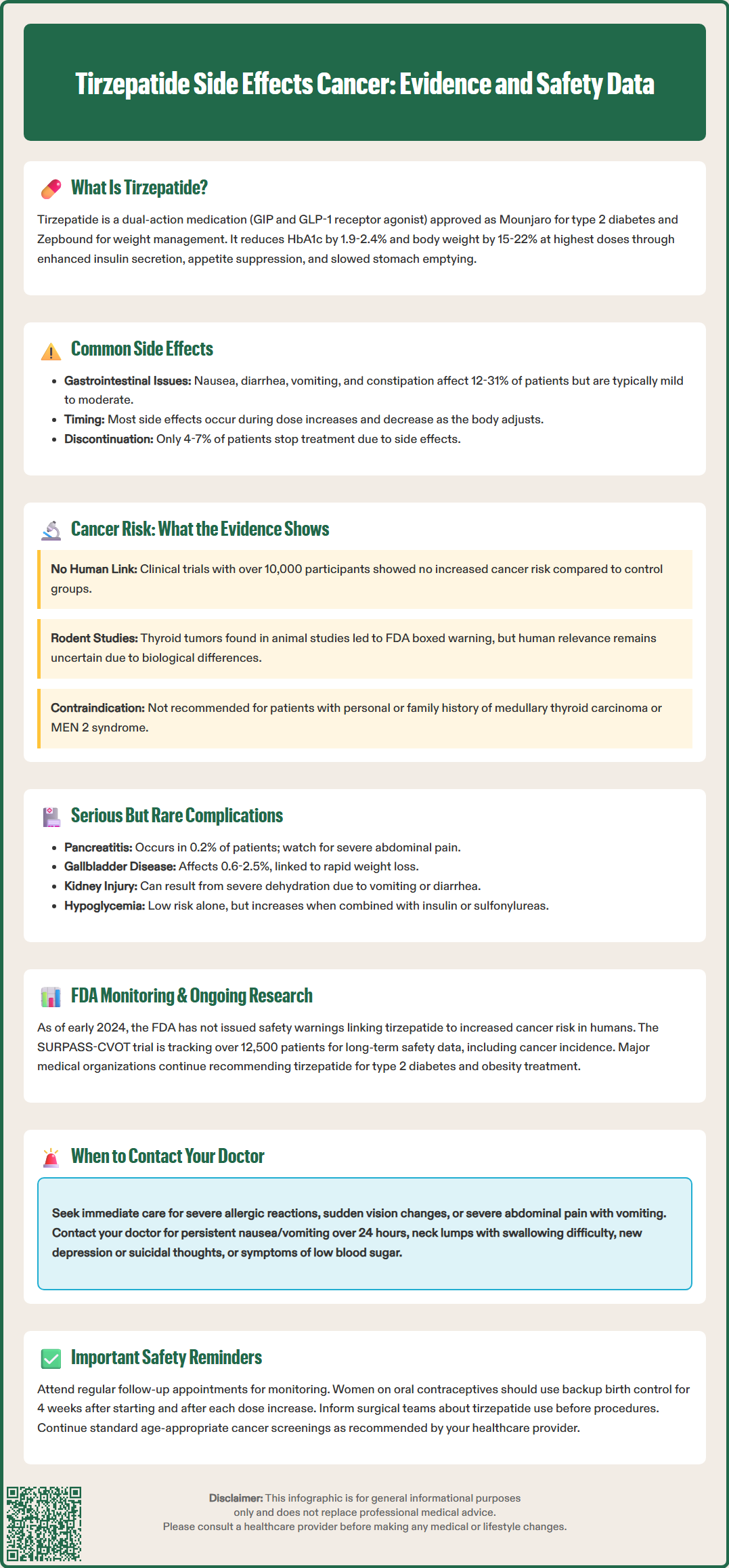LOSE WEIGHT WITH MEDICAL SUPPORT — BUILT FOR MEN
- Your personalised programme is built around medical care, not willpower.
- No generic diets. No guesswork.
- Just science-backed results and expert support.
Find out if you’re eligible

Tirzepatide, marketed as Mounjaro for type 2 diabetes and Zepbound for weight management, has raised questions about potential cancer risks. While preclinical rodent studies identified thyroid C-cell tumors, leading to FDA boxed warnings, no established causal link exists between tirzepatide use and increased cancer risk in humans. Clinical trials involving over 10,000 participants showed cancer incidence rates comparable to control groups. This article examines the evidence on tirzepatide side effects and cancer risk, reviews FDA safety monitoring, and provides guidance on when to seek medical attention.
Quick Answer: No established causal link exists between tirzepatide use and increased cancer risk in humans, though rodent studies led to FDA warnings about thyroid C-cell tumors.
Tirzepatide is a novel glucose-dependent insulinotropic polypeptide (GIP) and glucagon-like peptide-1 (GLP-1) receptor agonist approved by the FDA for two primary indications. Marketed as Mounjaro for type 2 diabetes mellitus and as Zepbound for chronic weight management, tirzepatide represents a significant advancement in metabolic disease treatment.
The medication works through a dual mechanism of action. As a GIP receptor agonist, it enhances insulin secretion and may improve insulin sensitivity. Simultaneously, its GLP-1 receptor agonist activity suppresses glucagon secretion, slows gastric emptying, and reduces appetite through central nervous system pathways. This combined approach results in improved glycemic control and substantial weight reduction, with clinical trials demonstrating HbA1c reductions of 1.9% to 2.4% and weight loss of approximately 15% to 22% of body weight at the highest doses in specific trials such as SURMOUNT-1.
Tirzepatide is administered as a once-weekly subcutaneous injection, with doses ranging from 2.5 mg to 15 mg. The medication is initiated at a lower dose and gradually titrated upward to minimize gastrointestinal side effects and optimize therapeutic response. For type 2 diabetes, tirzepatide is indicated as an adjunct to diet and exercise. For weight management, it is approved for adults with obesity (BMI ≥30 kg/m²) or overweight (BMI ≥27 kg/m²) with at least one weight-related comorbidity, as an adjunct to a reduced-calorie diet and increased physical activity.
Important limitations of use include: tirzepatide is not indicated for type 1 diabetes and has not been studied in patients with severe gastrointestinal disease, including severe gastroparesis. For women using oral contraceptives, effectiveness may be reduced during tirzepatide initiation and dose escalation; alternative contraceptive methods should be considered for 4 weeks after starting treatment and after each dose increase. Tirzepatide is not recommended during pregnancy, particularly for weight management, and should be used with caution in breastfeeding women.
Given the medication's relatively recent approval—Mounjaro in May 2022 and Zepbound in November 2023—ongoing post-marketing surveillance continues to evaluate long-term safety outcomes, including potential associations with serious adverse events such as malignancy.

Clinical trials of tirzepatide have established a well-characterized adverse effect profile, with gastrointestinal symptoms representing the most common treatment-related events. In the pivotal SURPASS clinical trial program evaluating tirzepatide for type 2 diabetes, and the SURMOUNT trials for weight management, gastrointestinal adverse effects were frequently reported.
The most commonly reported side effects include:
Nausea: Affecting 12% to 24% of patients with type 2 diabetes and 24% to 31% in weight management trials
Diarrhea: 12% to 17% in diabetes trials and 18% to 23% in weight management trials
Decreased appetite: 5% to 10% of patients
Vomiting: 5% to 10% in diabetes trials and 8% to 12% in weight management trials
Constipation: 5% to 7% in diabetes trials and 16% to 17% in weight management trials
Dyspepsia: 5% to 9% of patients
Abdominal pain: 5% to 9% of patients
Alopecia (hair loss): Reported in weight management trials
These symptoms are typically mild to moderate in severity, occur most commonly during dose escalation, and tend to diminish over time as patients develop tolerance. Discontinuation rates due to gastrointestinal adverse effects ranged from 4% to 7% across clinical trials.
Other notable adverse effects include:
Hypoglycemia: Low risk when used as monotherapy, but increased when combined with insulin or sulfonylureas
Injection site reactions: Erythema, pruritus, or discomfort in approximately 2% to 4% of patients
Fatigue and dizziness: Reported in 5% to 8% of participants
Increased heart rate: Mean increases of 2 to 4 beats per minute observed
Serious adverse events were uncommon but included acute pancreatitis (approximately 0.2% incidence), gallbladder disease including cholecystitis and cholelithiasis (0.6% in diabetes trials and up to 2.5% in weight management trials, associated with rapid weight loss), and acute kidney injury, typically in the context of severe dehydration from gastrointestinal symptoms. Tirzepatide should be discontinued promptly if pancreatitis is suspected and not restarted if pancreatitis is confirmed.
Patients with preexisting diabetic retinopathy should be monitored for progression during rapid improvement in glycemic control. For the weight management indication (Zepbound), suicidal ideation and behavior have been reported, and patients should be monitored for new or worsening depression, suicidal thoughts, or unusual behavior changes.
The FDA prescribing information includes boxed warnings regarding thyroid C-cell tumors based on rodent studies, though the clinical relevance to humans remains uncertain.
The relationship between tirzepatide and cancer risk has generated considerable interest, particularly given the medication's mechanism of action and findings from preclinical studies. Currently, there is no established causal link between tirzepatide use and increased cancer risk in humans, though several important considerations warrant discussion.
Preclinical rodent studies identified thyroid C-cell tumors (medullary thyroid carcinoma) in rats and mice exposed to tirzepatide at clinically relevant doses. This finding led to a boxed warning in the FDA prescribing information and contraindication in patients with a personal or family history of medullary thyroid carcinoma or Multiple Endocrine Neoplasia syndrome type 2 (MEN 2). However, the relevance of these rodent findings to humans is uncertain, as rodents have substantially higher densities of GLP-1 receptors in thyroid C-cells compared to humans.
In clinical trials encompassing over 10,000 participants with exposure periods up to 72 weeks, cancer incidence rates were low and comparable between tirzepatide and comparator groups. The SURPASS-CVOT trial, an ongoing cardiovascular outcomes study with approximately 12,500 participants, will provide more definitive long-term safety data regarding malignancy risk.
Some observational data suggest that GLP-1 receptor agonists as a class may be associated with altered risk of certain obesity-related cancers, potentially through weight loss and improved metabolic parameters. However, these findings are preliminary, often limited by confounding factors and relatively short follow-up periods for cancers with long latency periods. Prospective studies with longer follow-up are needed to establish any definitive relationship.
Patients should be counseled that while thyroid tumors occurred in animal studies, no increased cancer risk has been demonstrated in human trials to date. Routine screening with serum calcitonin or thyroid ultrasound is not recommended based on current evidence. Patients should report symptoms such as a neck mass, hoarseness, difficulty swallowing, or persistent cough for appropriate evaluation. Standard age- and risk-appropriate cancer screening should continue as recommended for the general population, and tirzepatide should not be used in individuals with contraindicated thyroid conditions.
The FDA employs comprehensive post-marketing surveillance systems to monitor the safety of tirzepatide and other newly approved medications. Through the FDA Adverse Event Reporting System (FAERS), healthcare providers and patients can report suspected adverse events, including potential malignancies, enabling the agency to detect safety signals that may not have been apparent in pre-approval clinical trials.
As of early 2024, the FDA has not issued any safety communications specifically linking tirzepatide to increased cancer risk in humans. The agency continues to require the manufacturer, Eli Lilly, to conduct post-marketing studies, including the SURPASS-CVOT cardiovascular outcomes trial, which will provide extended safety data on over 12,500 patients. This study includes comprehensive adverse event monitoring, including malignancy incidence and type.
Ongoing research is examining several important questions regarding tirzepatide's long-term safety profile:
Thyroid cancer surveillance: Prospective monitoring of thyroid-related adverse events in large patient cohorts
Pancreatic safety: Evaluation of pancreatitis and pancreatic cancer risk with extended exposure
Gallbladder disease: Assessment of cholecystitis and cholelithiasis incidence with rapid weight loss
Comparative safety: Head-to-head comparisons with other incretin-based therapies
The American Diabetes Association and American Association of Clinical Endocrinology (AACE) continue to recommend tirzepatide as an effective treatment option for type 2 diabetes and obesity, with the understanding that ongoing surveillance will further clarify its long-term safety profile. Healthcare providers are encouraged to report any unexpected adverse events through the FDA MedWatch program (www.fda.gov/medwatch or 1-800-FDA-1088) to contribute to the collective understanding of tirzepatide's safety.
Patients taking tirzepatide should be educated about expected side effects and warning signs that require prompt medical evaluation. While most adverse effects are mild and self-limiting, certain symptoms warrant immediate healthcare provider contact or emergency medical attention.
Contact your healthcare provider promptly if you experience:
Persistent gastrointestinal symptoms: Severe nausea, vomiting, or diarrhea lasting more than 24 hours, particularly if accompanied by signs of dehydration (decreased urination, dizziness, dry mouth)
Abdominal pain: Severe or persistent pain, especially in the upper abdomen radiating to the back, which may indicate pancreatitis
Gallbladder symptoms: Right upper quadrant pain, particularly after meals, with or without fever and jaundice
Hypoglycemia: Symptoms including shakiness, sweating, confusion, rapid heartbeat, or difficulty concentrating, especially if taking tirzepatide with insulin or sulfonylureas
Kidney problems: Decreased urination, swelling in legs or feet, unusual fatigue, or confusion
Mental health changes: New or worsening depression, suicidal thoughts, or unusual changes in mood or behavior
Pregnancy: If you become pregnant or are planning pregnancy while taking tirzepatide, especially for weight management
Seek emergency medical attention for:
Severe allergic reactions: Difficulty breathing, facial or throat swelling, severe rash, or rapid heartbeat
Severe abdominal pain: Particularly if accompanied by vomiting and inability to tolerate oral intake
Vision changes: Sudden vision loss or blurred vision, which may indicate diabetic retinopathy complications
Thyroid concerns: A lump or swelling in the neck, hoarseness, difficulty swallowing, or persistent cough
Patients should maintain regular follow-up appointments for monitoring of glycemic control, weight, and potential adverse effects. Routine laboratory monitoring typically includes renal function, particularly during dose titration, and periodic assessment of pancreatic enzymes if abdominal symptoms develop. If you are scheduled for surgery, inform your anesthesia and surgical teams about your tirzepatide use, as delayed gastric emptying may increase aspiration risk during anesthesia.
Any new or unusual symptoms, including unexplained weight loss beyond expected therapeutic effects, persistent fatigue, or changes in bowel habits, should be reported to your healthcare provider for appropriate evaluation.
Currently, there is no established causal link between tirzepatide use and increased cancer risk in humans. Clinical trials with over 10,000 participants showed cancer incidence rates comparable to control groups, though rodent studies identified thyroid C-cell tumors leading to FDA warnings.
Tirzepatide is contraindicated in patients with a personal or family history of medullary thyroid carcinoma or Multiple Endocrine Neoplasia syndrome type 2 (MEN 2) due to thyroid C-cell tumor findings in rodent studies.
The most common side effects are gastrointestinal, including nausea (12-31%), diarrhea (12-23%), vomiting (5-12%), and constipation (5-17%). These symptoms are typically mild to moderate, occur during dose escalation, and diminish over time.
All medical content on this blog is created using reputable, evidence-based sources and is regularly reviewed for accuracy and relevance. While we strive to keep our content current with the latest research and clinical guidelines, it is intended for general informational purposes only.
This content is not a substitute for professional medical advice, diagnosis, or treatment. Always consult a licensed healthcare provider with any medical questions or concerns. Use of this information is at your own risk, and we are not liable for any outcomes resulting from its use.